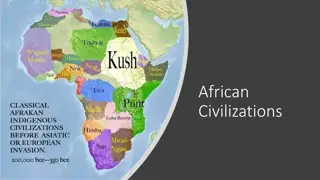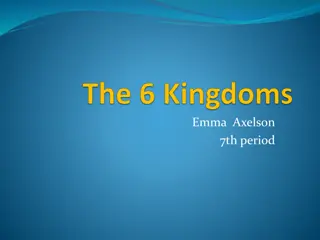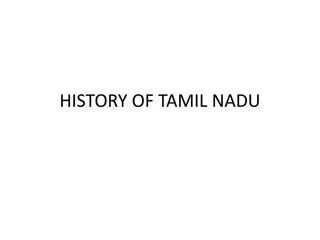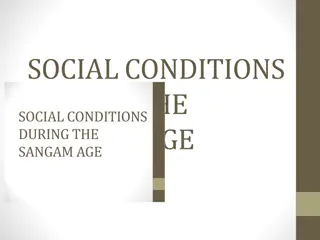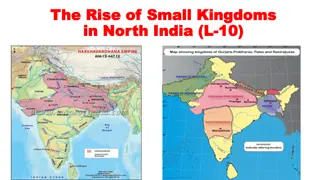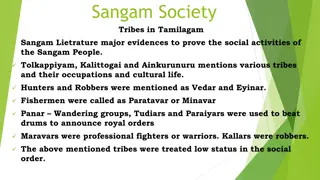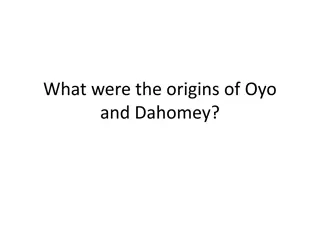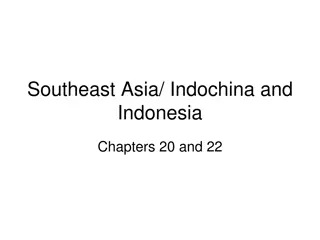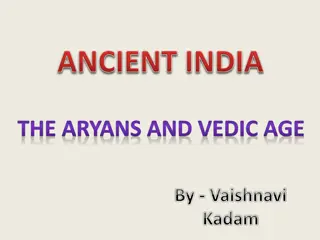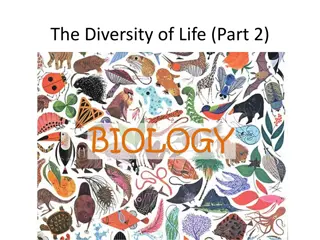Insights into the Sangam Age and the Three Kingdoms of Tamilakam
Explore the rich historical era of Tamilakam during the Sangam Age, featuring the Cholas, Cheras, and Pandyas dynasties vying for supremacy in South India. Learn about the literary treasures of Sangam literature and the significant contributions of these three kingdoms to the cultural landscape of ancient Tamilakam.
Download Presentation

Please find below an Image/Link to download the presentation.
The content on the website is provided AS IS for your information and personal use only. It may not be sold, licensed, or shared on other websites without obtaining consent from the author. Download presentation by click this link. If you encounter any issues during the download, it is possible that the publisher has removed the file from their server.
E N D
Presentation Transcript
THE POST MAURYAN PERIOD - HARINI.B.G
INTRODUCTION Tamilakam or the tamil region, known today as South India, lies south of the Krishna river. It was ruled by Cholas, Cheras and the Pandyas. The Sangam literature is our main source of information about these dynasties. This period in the history of Tamilakam is thus known as the Sangam Age
THE SANGAM TEXTS Sangam literature is the name given to the earliest available Tamil literature. The Sangam age roughly extends between 300 BCE and 300 CE, although most of the work is believed to have been composed between 100 CE and 250 CE. The word 'Sangam' literally means association. About 2,200 years ago, there was a gathering of Tamil poets and scholars under the patronage of the Pandyan king. The third and the most important assembly was held in Madurai. Over 2000 poems were composed in Tamil during this assembly. Later, these poems were compiled into many books.
THE THREE KINGDOMS OF TAMILAKAM The three ruling houses of Tamil India, the Pandyas, Cheras, and Cholas, fought for supremacy of southern India and Sri Lanka. These dynasties promoted early literature on the Indian subcontinent and built important Hindu temples.
THE CHOLAS The Chola dynasty was a Tamil thalassocratic empire of southern India and one of the longest-ruling dynasties in world history. The earliest datable references to the Chola are from inscriptions dated to the 3rd century BCE during the reign of Ashoka of the Maurya Empire. The cholas ruled in the Kaveri delta. Their capital was Uraiyur. The most powerful king was Karikala. He fought against the Cheras and the Pandyas.
THE CHERAS Cheras of the Kongu country are known to have controlled western Tamil Nadu in the early medieval period. Vanji was their capital. The most famous Chera king was Neduncheraladan. The Chera rulers encouraged trade. They traded with Rome and Egypt.
THE PANDYAS The Pandya dynasty, also referred to as the Pandyas of Madurai, was an ancient Tamil dynasty of South India, and among the three great kingdoms of Tamilakam, the other two being the Cholas and the Cheras. The Pandyas controlled the region around Madurai. According to Magesthenes, the kingdom was ruled by a woman who had a large army. Nedunchezhyan was a powerful ruler of the Pandya. The kingdom was famous for pearls.
THE NORTH AND THE DECCAN While the sangam literature was being written in the north the tribes from central Asia crossed the Hindukush and entered India. These were the Indo-Greeks or the Bactrian Greeks, the Shakas or Scythians, the Pahlavas or the Parthians and the Kushanas.
THE KUSHANAS Kushan dynasty, Kushan also spelled Kusana, ruling line descended from the Yuezhi, a people that ruled over most of the northern Indian subcontinent, Afghanistan, and parts of Central Asia during the first three centuries of the Common Era. They defeated Indo-Greeks, the Pahlavas and the Shakas and established themselves in the region around Taxila and Pashawar.
THE KANISHKA Kanishka, was an emperor of the Kushan dynasty, under whose reign the empire reached its zenith. He is famous for his military, political, and spiritual achievements.
THE SATAVAHANAS The Satavahanas, also referred to as the Andhras in the Puranas, were an ancient Indian dynasty based in the Deccan region. Some powerful rulers were Sri Satakarni, Vasishthiputra, Pulumayi, Yajnasri Satakarni and Gautamiputra Sri Satakarni, the most powerful of them.
TRADE Trade flourished during this period. The Indo-Greeks, Kushanas and the Satavahanas issued a large number of gold, silver and copper coins. Ports such as Broach, Kalyan and Sopara were the main centers of trade with other countries.
RELIGION Buddhism is one of the world's largest religions and originated 2,500 years ago in India. Hindus believe in the doctrines of samsara (the continuous cycle of life, death, and reincarnation) and karma (the universal law of cause and effect). Buddhism and Hinduism were the most widely followed religions. Buddhism was divided into two sects Hinayana and Mahayana. Hinayana was the earlier and the simpler form of Buddhism. Mahayana was the new form, with many rituals and ceremonies. Menander, the Indo-Greek ruler and Kanishka were Buddhists. They gifted land to Buddhist monks. Wealthy merchants, many of them Buddhists, also gave liberal donations to Buddhist monasteries. Nagarjunakonda and Amaravati were famous centres of the Buddhist culture.
SPREAD OF BUDDHISM A wave of conversion began, and Buddhism spread not only through India, but also internationally. Ceylon, Burma, Nepal, Tibet, central Asia, China, and Japan are just some of the regions where the Middle Path was widely accepted. The Silk Route helped greatly in the spread of Buddhism to Central Asia and China.


